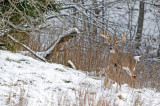
Remember all those best-laid plans from last summer? Remember how you were going to tag a giant on a bed-to-feed pattern in September? The scrapeline success that was sure to come in October? The action-packed funnel sits in November?
Gone. All of them.
There’s no two ways about it: The season is dwindling and you’ve still got tags to fill. Here are five top-notch spots to kill a late-season buck.
Spot 1: The Best Food We’ll get the boring one out of the way first. Yes, when the weather turns bitter and the rut is but a memory, bucks are worn out, in need of recovery, and food-focused. This is not a secret tactic by any means and is the dominant topic of conversation any time the talk turns to late-season hunting.
If you’re fortunate enough to own your own chunk of whitetail paradise, then you have some measure of control over the quality of late-season forage available. If you hunt public land or by-permission private ground, you’re at the mercy of the native browse and what grain remains in ag fields.
The best food available is going to attract the most deer. In the late season, I’m a numbers guy. I want to hunt the place that’s drawing the most deer. This isn’t a time to get cute and think you’ll find a “secret” feed location that an old buck is using. Maybe that can happen, but I’ve never seen it. When I’ve seen big bucks that have survived the gauntlet of gun season, it’s because I’ve had access to a prime food source near security cover that’s drawing a bunch of deer. Without that cover, those bucks won’t be there regardless of the food source quality.
Spot 2: Hidden Cover As mentioned above, security cover is a key to late-season success, particularly on older bucks living in pressured areas. It’s simple: If you don’t have cover that allows bucks to live past gun season, you don’t have older bucks to hunt. There is no leeway.
That security cover is another key to late-season opportunities. But it can’t simply be thick cover. It needs to be cover that’s “hidden,” whether it just can’t be seen from a road or it’s something that allows bucks to hide in plain sight, the bottom line is the same. They must have a place where they feel safe.
That hidden cover shouldn’t be messed with. Late-season hunts can focus on such spots, but you have to be careful not to blow it out. I like to hunt the fringes and try to catch bucks as they enter or exit on their way to bed in the mornings or feed in the evenings.
Spot 3: Bedding Thickets This other cover-oriented spot is a favorite when the weather turns from mega-cold and snowy to sunny and warm (with “warm” being a somewhat relative term). Temps in the mid-30s can seem almost tropical after sustained periods in the teens. On the first day of this warming trend, one of the best spots to be can on the edge of a known area of thick bedding cover. This is a late morning affair. I don’t try to beat these deer to bed. I like to wait until gray light and slowly work my way into position to avoid spooking deer.
Settle in and wait. When that sun climbs higher in the sky and the day starts to warm up, deer will begin to mill around. Don’t expect them to move far but they will get up and move around that bedding cover.
Spot 4: The Overlooked Oak Ridge Acorns were the deal throughout much of the opening weeks of deer season. Deer (and turkeys and squirrels) are efficient feeders and most of those acorns have long since been consumed. But maybe not all.
In areas with a proliferation of oaks (think Appalachia and the heart of the Midwest), it’s likely there are still some acorns lying beneath the fallen leaves. Find ridges with nuts and you’ll find great spots to kill a late-season buck. Finding that area can require plenty of walking. Snow can make the job a bit easier as there will be no mistaking an area that’s holding remnant acorns.
Spot 5: The Last Green Focusing again on areas of big timber, greenbrier can be a top-notch food source late in the season. It’s typically the last green food available and it will draw plenty of deer.
Greenbrier is also found in areas of cover which makes it even better during the late season when pressure-savvy bucks are reluctant to hit open fields in daylight.
Keep food and cover in mind this late season, but above all if you still have a tag, the most important thing is to get out there.
Feature image via Matt Hansen.






